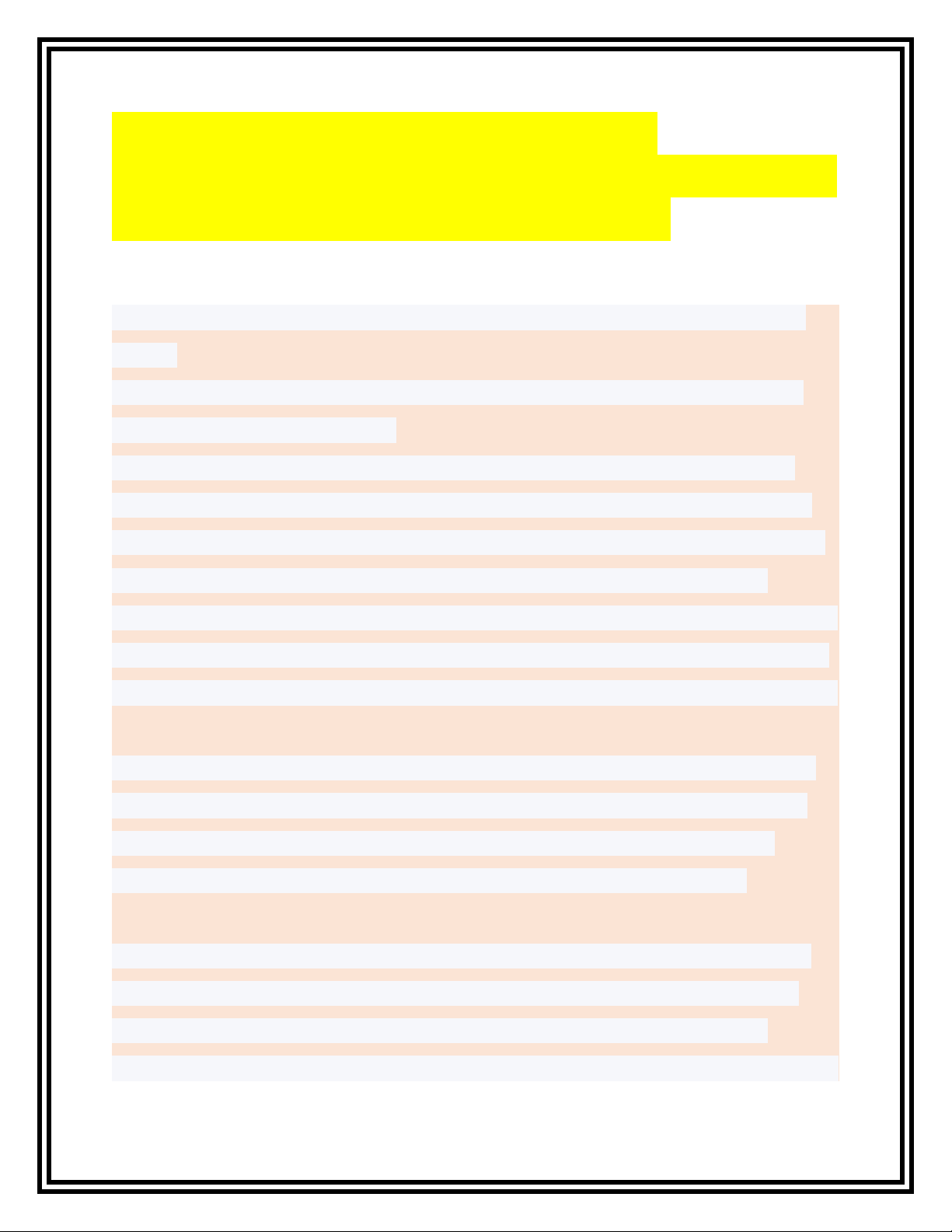
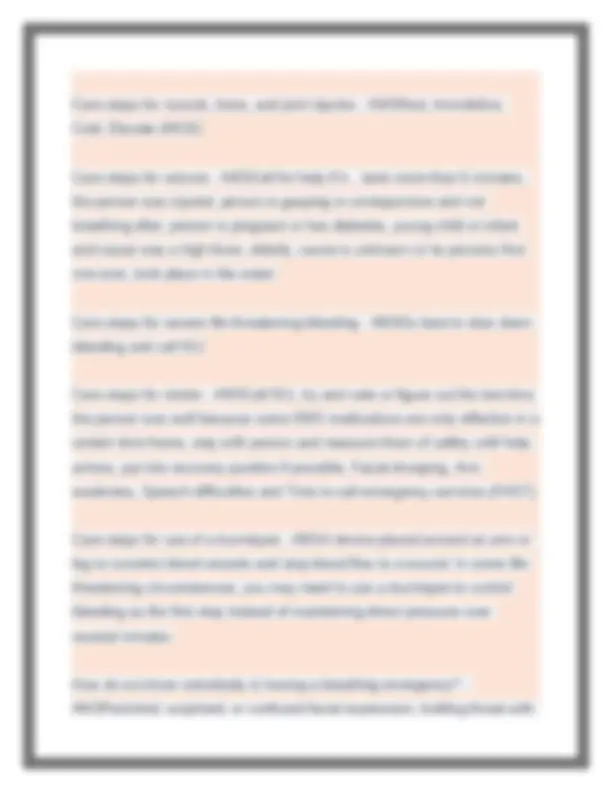
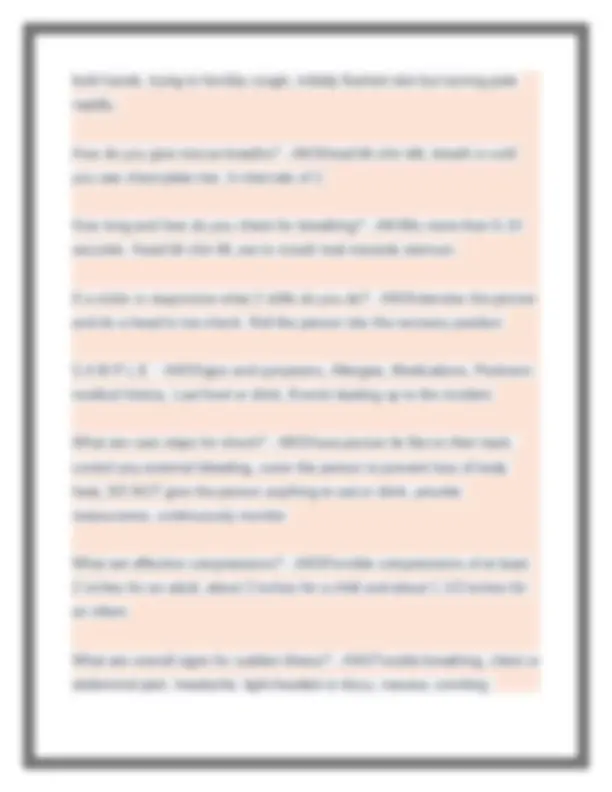
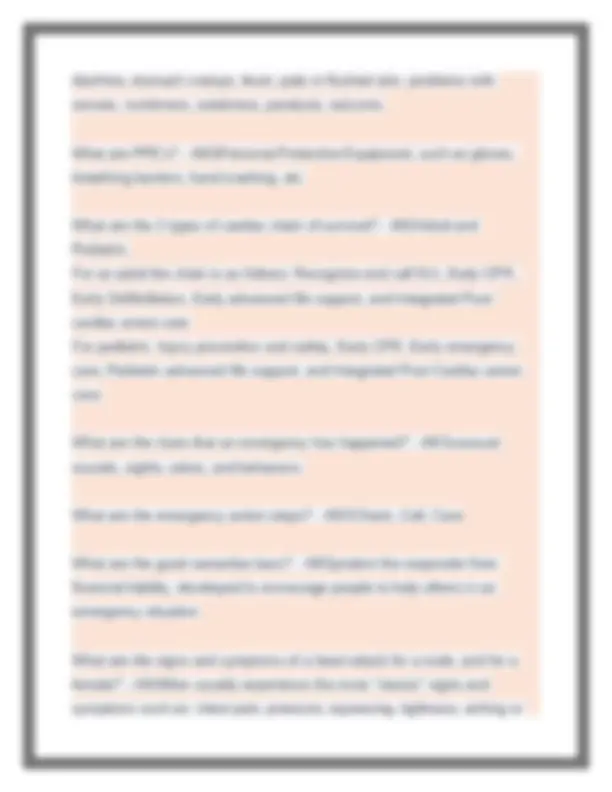
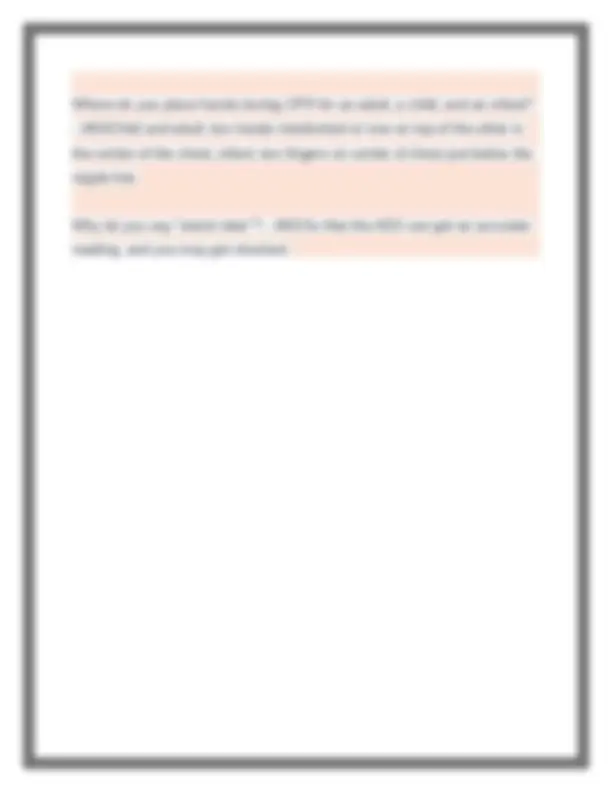


Study with the several resources on Docsity

Earn points by helping other students or get them with a premium plan


Prepare for your exams
Study with the several resources on Docsity

Earn points to download
Earn points by helping other students or get them with a premium plan
Community
Ask the community for help and clear up your study doubts
Discover the best universities in your country according to Docsity users
Free resources
Download our free guides on studying techniques, anxiety management strategies, and thesis advice from Docsity tutors
Red Cross CPR/AED/ First Aid Certification Test Questions and Correct Answers Updated 2025 Rated A
Typology: Exams
1 / 8

This page cannot be seen from the preview
Don't miss anything!





Care Steps for anaphylaxis - ANSIf you know that the person has had a severe allergic reaction before, and the person is having trouble breathing or is showing signs and symptoms of anaphylaxis, have someone call 9-1-1 or the designated emergency number immediately. If the person carries medication (e.g., epinephrine) used for the emergency treatment of anaphylaxis, offer to help the person use the medication. If you are alone, help the person administer the medication and then call 9-1-1 or the designated emergency number. While you wait for help to arrive, make sure the person is sitting in a comfortable position, or have the person lie down if he or she is showing signs of shock. Care steps for bleeding wounds - ANSFor a minor bleeding wounds, use gauze pads and a wrap to apply pressure and stop up the bleeding until you can get help. Major bleeding wounds require immediate medical attention, so do your best to slow down bleeding until help arrives. Care steps for burn - ANSStop the source of the burn, cool the burn and relieve pain using clean, cool or cold water for at least 10 minutes. Use water that you could drink. Never use ice or ice water to cool a burn because doing so can cause more damage to the skin. If clean cool or cold
water is not available, you can apply a cool or cold (but not freezing) compress instead. Cover with a lovely sterile dressing. Care steps for concussions - ANSAdvise the person to stop the activity he or she was engaged in when the incident occurred. The person should follow up with a healthcare provider for a full evaluation. A healthcare provider is best able to evaluate the severity of the injury and make recommendations about when the person can return to normal activities. And, while rare, permanent brain injury and death are potential consequences of failing to identify and respond to a concussion in a timely manner. Care steps for diabetic emergency - ANSCall 911 if person is unresponsive, interview bystanders and do head to toe check, check the airway, if person has a history use a suitable form of sugar such as fruit juice, glucose tablets, fruit strips, chewable candies, regular soda, milk, a spoonful of sugar in a glass of water. Care steps for head, neck, and back injury - ANSAlways assume that an injury involving the head, neck or spine is serious and provide care accordingly. If you suspect a head, neck or spinal injury, call 9-1-1 or the designated emergency number. As long as the person is breathing normally, have him or her remain in the position in which he or she was found. If the person is wearing a helmet, do not remove it unless you are specifically trained to do so and removing the helmet is necessary to give CPR. Similarly, if a child is strapped into a car seat, do not remove him or her from it unless you need to give the child CPR.
both hands, trying to forcibly cough, initially flushed skin but turning pale rapidly. How do you give rescue breaths? - ANSHead tilt chin left, breath in until you see chest plate rise. In intervals of 2. How long and how do you check for breathing? - ANSNo more than 5- seconds. Head tilt chin lift, ear to mouth look towards sternum. If a victim is responsive what 2 skills do you do? - ANSInterview the person and do a head to toe check. Roll the person into the recovery position. S.A.M.P.L.E. - ANSSigns and symptoms, Allergies, Medications, Pertinent medical history, Last food or drink, Events leading up to the incident. What are care steps for shock? - ANSHave person lie flat on their back, control any external bleeding, cover the person to prevent loss of body heat, DO NOT give the person anything to eat or drink, provide reassurance, continuously monitor. What are effective compressions? - ANSForcible compressions of at least 2 inches for an adult, about 2 inches for a child and about 1 1/2 inches for an infant. What are overall signs for sudden illness? - ANSTrouble breathing, chest or abdominal pain, headache, light-headed or dizzy, nausea, vomiting,
diarrhea, stomach cramps, fever, pale or flushed skin, problems with senses, numbness, weakness, paralysis, seizures. What are PPE's? - ANSPersonal Protective Equipment, such as gloves, breathing barriers, hand washing, etc. What are the 2 types of cardiac chain of survival? - ANSAdult and Pediatric. For an adult the chain is as follows: Recognize and call 911, Early CPR, Early Defibrillation, Early advanced life support, and Integrated Post- cardiac arrest care. For pediatric: Injury prevention and safety, Early CPR, Early emergency care, Pediatric advanced life support, and Integrated Post-Cardiac arrest care. What are the clues that an emergency has happened? - ANSunusual sounds, sights, odors, and behaviors. What are the emergency action steps? - ANSCheck, Call, Care What are the good samaritan laws? - ANSprotect the responder from financial liability, developed to encourage people to help others in an emergency situation. What are the signs and symptoms of a heart attack for a male, and for a female? - ANSMen usually experience the more "classic" signs and symptoms such as: chest pain, pressure, squeezing, tightness, aching or
professional takes over, scene becomes unsafe, or person shows obvious signs of life. What is implied consent? - ANSsomebody who is unresponsive, confused, or mentally impaired, also applies to a minor in a medical emergency situation when a parent or guardian is not around. What is the first thing you do with and AED? - ANSTurn it on What is the purpose of and AED? - ANSCan correct the underlying problem for some people who go into sudden cardiac arrest. Two abnormal heart rhythms in particular, ventricular fibrillation (V-fib) and ventricular tachycardia (V-tach). What leads to cardiac issues in infants & children? - ANS When is an AED used? - ANSWhenever it is available and as soon as possible when it is available. When is it time to call 911? - ANSwhen the situation has become one of the emergency situations or you recognize emergency conditions in play When the AED prompts analyzing, what should you do? - ANSStand clear and deliver a shock Where do the pads go on the victim? - ANSUpper ride side of the chest and lower left side of the chest near the armpit of the victim
Where do you place hands during CPR for an adult, a child, and an infant?